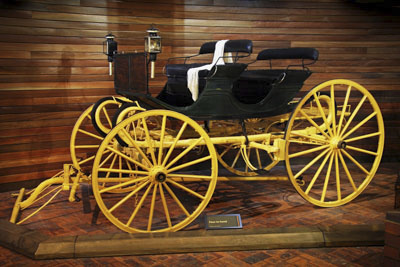Drop Shaft Sulky
Production date
1900-1920
Country
Australia
State/Province
Queensland
See full details
Object detail
Description
2 seats, 1 horse, 2 wheels, each with 16 spokes. Carriage body black with red and beige lining. Undercarriage red with black and beige lining. Front splash board clear varnish with white and beige lining. Includes a sulky lamp strongly secured to right side. Open, no canopy. Right foot brake operates metal arm and flat plate on to right rear wheel. Mud guards positioned high above wheel.. Metal canister at right front for holding whip. Turning adjustment lever under front seat. Kerosene lamp attached near left wheel.
Classification
TRANSPORT Horse sulky
Production date
1900-1920
Production place
Measurements
L3700 x H1440 x W1680
Media/Materials description
Leather (Animal/Human Remains)
Iron (Metals - Ferrous)
Indeterminate (Metals - Indeterminate)
Indeterminate (Woods)
Iron (Metals - Ferrous)
Indeterminate (Metals - Indeterminate)
Indeterminate (Woods)
Signature/Marks
NOCK & JOHNSON / BRISBANE
History and use
This sulky was sed by the local mailman in the Pinkenba area. A brake is rarely found on such small vehicles which rely on the breeching of the horse for stopping. The brake ensured the vehicle stopped right next to the mailbox, and the mailman did not have to leave his seat. This vehicle was made by Nock & Johnson of Brisbane, in about 1910.
The name 'Sulky' derives from English and American vehicles, where the driver sat high and alone, giving the impression that he was sulking. These light vehicles were the most popular in Australia because of their low cost, stability and comfort. The 'drop shaft' allowed for easier access. These sulkies were popular with ladies who had to climb into the vehicle in the long dresses of the era. Drop shaft sulkies were a Queensland innovation, and were sometimes called Brisbane or Queensland sulkies interstate.
The name 'Sulky' derives from English and American vehicles, where the driver sat high and alone, giving the impression that he was sulking. These light vehicles were the most popular in Australia because of their low cost, stability and comfort. The 'drop shaft' allowed for easier access. These sulkies were popular with ladies who had to climb into the vehicle in the long dresses of the era. Drop shaft sulkies were a Queensland innovation, and were sometimes called Brisbane or Queensland sulkies interstate.
Associated person
Registration number
H5422




